Study and Validation of a Novel Grouting Clamp Type Deepwater Oilfield Pipeline Repair Method Based on Computational Fluid Dynamics
Abstract
1. Introduction
2. Materials and Methods
2.1. Pipeline Repair Method
2.2. Non-Solid Phase Silicone Plugging Agent Properties Test
2.2.1. Curing Properties Test
2.2.2. Mechanical Properties Test
2.3. Simulation of Erosion Test
2.3.1. Curing Properties Test
2.3.2. Boundary Conditions and Meshing
2.3.3. Simulation Test Setup
3. Results and Discussion
3.1. Results and Discussion on Plugging Agent Curing Properties Test
- (1)
- When the plugging agent curing agent ratio was 100:10 or 100:15, the curing of the plugging agent failed because of the formulation’s comparatively low mass ratio of the curing agent;
- (2)
- With manual mixing and no pressure, Figure 7a illustrates how the plugging agent failed to completely fill after curing when the ratio of the plugging agent was 100:22. The sleeve was not sufficiently sealed, which is the cause;
- (3)
- The sleeve was enhanced for sealing; no plugging agent leaked, but after curing, tiny fractures appeared, as illustrated in Figure 7b. This occurred due to two reasons: (a) The gas was not totally expelled during mixing, and when it warmed up during curing, it progressively separated and collected; (b) the plugging agent has to be pressured during curing;
- (4)
- A 100:22 liquid to plugging agent ratio, electric stirring, and a 300 psi pressured environment indicate a successful plugging of agent curing. The organic–inorganic interfacial cementing force between the plugging agent and the pipeline was harmed and a crack channel developed when the test pressure surpassed 500 psi. The cause was due to the fact that the plugging agent’s interaction with the pipeline was affected by the existence of free gas in the plugging agent, and that the plugging agent’s curing process was not pressured sufficiently;
- (5)
- A 100:22 liquid to solids ratio plugging agent, vacuum degassing, and pressured 600 psi condition ensured a plugging agent curing success. Unfortunately, the pipeline between the plugging agent and the test pressure caused bonding damage when it surpassed 1000 psi. To explain why this occurred, the force and adhesive strength of the plugging agent after curing were influenced by the plugging agent’s pace and uniformity of curing;
- (6)
- As shown in Figure 7c, the plugging agent was satisfactorily healed at a 600 psi pressure with electric stirring and vacuum degassing when the plugging agent ratio was 100:25. For the 1500 psi test pressure, a constant pressure for 15 min without decreasing was maintained.
3.2. Results and Discussion on Plugging Agent Mechanical Properties Test
3.3. Results and Discussion on Erosion Test
3.3.1. Results and Discussion on Seawater Erosion
3.3.2. Results and Discussion on Crude Oil Erosion
4. Conclusions
- (1)
- The optimal quality ratio of the primary agent and curing agent in the plugging agent composition was found to be 100:25. The curing process required the addition of electric stirring, vacuum degassing, and pressurization processes;
- (2)
- The final compressive and bonding strengths of the plugging agent after solidification were found to be 143 MPa and 11.6 MPa, respectively. The mechanical characteristics of the plugging agent were evaluated to analyze the variation in compressive strength and in cementing strength with displacement;
- (3)
- The spatial model of the flow field of seawater and crude oil, the numerical model of the outer sleeve and plugging agent, and the analytical method of the complicated flow field of deepwater environment on the erosion impact of plugging agent were all created based on the CFD method;
- (4)
- Through numerical simulation tests using seawater and crude oil, the mathematical relationships between the maximum pressure of the plugging agent and the velocities of the two fluids were established. The erosion effect of the fluids on the plugging agent was found to be less than their strength limits, thus confirming the viability and efficacy of this new method of pipeline rehabilitation.
Author Contributions
Funding
Institutional Review Board Statement
Informed Consent Statement
Data Availability Statement
Conflicts of Interest
References
- Wei, C. Status and challenges of Chinese deepwater oil and gas development. Pet. Sci. 2011, 8, 477–484. [Google Scholar]
- Abbas, M.; Shafiee, M. An overview of maintenance management strategies for corroded steel structures in extreme marine environments. Mar. Struct. 2020, 71, 102718. [Google Scholar] [CrossRef]
- Zhu, J.; Li, D.; Chang, W.; Wang, Z.; Hu, L.; Zhang, Y.; Wang, M.; Yang, Z.; Song, J.; Chen, S.; et al. In situ marine exposure study on corrosion behaviors of five alloys in coastal waters of western Pacific Ocean. J. Mater. Res. Technol. 2020, 9, 8104–8116. [Google Scholar] [CrossRef]
- Zhao, M.; Liu, M.; Lu, L.; Cheng, L.; An, H.; Draper, S. Local Scour Around Two Subsea Pipelines in An Oscillatory Flow; Taylor & Francis Group: London, UK, 2016; pp. 381–386. [Google Scholar]
- Peng, W.; Ma, L.; Wang, P.; Cao, X.; Xu, K.; Miao, Y. Experimental and CFD investigation of flow behavior and sand erosion pattern in a horizontal pipe bend under annular flow. Particuology 2023, 75, 11–25. [Google Scholar] [CrossRef]
- Hüsken, G.; Shamsuddoha, M.; Pirskawetz, S.; Hofmann, D.; Baeßler, M.; Kühne, H.-C. Potential of a repair system for grouted connections in offshore structures: Development and experimental verification. Mar. Struct. 2021, 77, 102934. [Google Scholar] [CrossRef]
- Igoe, D.; Spagnoli, G.; Doherty, P.; Weixler, L. Design of a novel drilled-and-grouted pile in sand for offshore oil&gas structures. Mar. Struct. 2014, 39, 39–49. [Google Scholar] [CrossRef]
- Ju, S.H.; Huang, Y.C. MTMD to increase fatigue life for OWT jacket structures using Powell’s method. Mar. Struct. 2020, 71, 102726. [Google Scholar] [CrossRef]
- Foorginezhad, S.; Mohseni-Dargah, M.; Firoozirad, K.; Aryai, V.; Razmjou, A.; Abbassi, R.; Garaniya, V.; Beheshti, A.; Asadnia, M. Recent Advances in Sensing and Assessment of Corrosion in Sewage Pipelines. Process. Saf. Environ. Prot. 2021, 147, 192–213. [Google Scholar] [CrossRef]
- Dou, B.; Ding, H.; Mao, X.-Y.; Feng, H.-R.; Chen, L.-Q. Modeling and parametric studies of retaining clips on pipes. Mech. Syst. Signal Process. 2023, 186, 109912. [Google Scholar] [CrossRef]
- Yu, J.; Xu, W.; Yu, Y.; Wang, H.; Li, H.; Xu, S.; Han, M. Effectiveness of concrete grouting method for deep-sea pipeline repairs. Thin-Walled Struct. 2021, 169, 108336. [Google Scholar] [CrossRef]
- Tziavos, N.I.; Hemida, H.; Dirar, S.; Papaelias, M.; Metje, N.; Baniotopoulos, C.C. Structural health monitoring of grouted connections for offshore wind turbines by means of acoustic emission: An experimental study. Renew. Energy 2020, 147, 130–140. [Google Scholar] [CrossRef]
- Tabeshpour, M.R.; Fatemi, M. Optimum arrangement of braces in jacket platform based on strength and ductility. Mar. Struct. 2020, 71, 102734. [Google Scholar] [CrossRef]
- Werner, M.; Lohaus, L. Influences of in situ production of grouted joints on aspects of structural safety. Bautechnik 2014, 91, 554–560. [Google Scholar]
- Dehghani, A.; Aslani, F. A review on defects in steel offshore structures and developed strengthening techniques. Structures 2019, 20, 635–657. [Google Scholar] [CrossRef]
- Dallyn, P.; El-Hamalawi, A.; Palmeri, A.; Knight, R. Prediction of Wear in Grouted Connections for Offshore Wind Turbine Generators. Structures 2017, 10, 117–129. [Google Scholar] [CrossRef]
- Chen, T.; Li, Z.; Wang, X.; Yuan, G.; Liu, J. Experimental study on ultimate bending performance of grouted connections in offshore wind turbine support structures. Thin-Walled Struct. 2018, 132, 522–536. [Google Scholar] [CrossRef]
- Cao, Y.; Zhang, S. Numerical analysis of cross-section ovalization in the deep-sea pipeline lateral buckling process. Mar. Georesources Geotechnol. 2019, 37, 477–487. [Google Scholar] [CrossRef]
- Suleymanov, V.A.; Buznikov, N.A. Multiphase Flow Assurance in an Extentional Subsea Pipeline: Effects of the Transported Fluid Composition and the Pipeline Route Profile. SOCAR Proc. 2021, 92–99. [Google Scholar] [CrossRef]
- Li, Y.; Ong, M.C.; Fuhrman, D.R. CFD investigations of scour beneath a submarine pipeline with the effect of upward seepage. Coast. Eng. 2020, 156, 103624. [Google Scholar] [CrossRef]
- Hu, D.; Tang, W.; Sun, L.; Li, F.; Ji, X.; Duan, Z. Numerical simulation of local scour around two pipelines in tandem using CFD–DEM method. Appl. Ocean Res. 2019, 93, 101968. [Google Scholar] [CrossRef]
- Han, F.; Liu, Y.; Ong, M.C.; Yin, G.; Li, W.; Wang, Z. CFD investigation of blind-tee effects on flow mixing mechanism in subsea pipelines. Eng. Appl. Comput. Fluid Mech. 2022, 16, 1395–1419. [Google Scholar] [CrossRef]
- Han, F.; Liu, Y.; Lan, Q.; Li, W.; Wang, Z. CFD Investigation on Secondary Flow Characteristics in Double-Curved Subsea Pipelines with Different Spatial Structures. J. Mar. Sci. Eng. 2022, 10, 1264. [Google Scholar] [CrossRef]
- Guo, X.; Stoesser, T.; Zhang, C.; Fu, C.; Nian, T. Effect of opening and wall boundaries on CFD modeling for submarine landslide-ambient water-pipeline interaction. Appl. Ocean Res. 2022, 126, 103266. [Google Scholar] [CrossRef]
- Guo, X.; Liu, X.; Luo, Q.; Chen, B.; Zhang, C. Dimensional effect of CFD analysis for submarine landslides interactions with infinite suspension pipelines. Ocean Eng. 2022, 266, 113094. [Google Scholar] [CrossRef]
- Fraga, V.S.; Yin, G.; Ong, M.C.; Myrhaug, D. CFD investigation on scour beneath different configurations of piggyback pipelines under steady current flow. Coast. Eng. 2021, 172, 104060. [Google Scholar] [CrossRef]
- Zhao, X.; Cao, X.; Zhang, J.; Cao, H.; Zhang, J.; Peng, W.; Bian, J. Experimental and numerical investigation of erosion in plugged tees for liquid-solid flow. Int. J. Multiph. Flow 2023, 160, 104348. [Google Scholar] [CrossRef]
- Yin, G.; Ong, M.C.; Zhang, P. Numerical investigations of pipe flow downstream a flow conditioner with bundle of tubes. Eng. Appl. Comput. Fluid Mech. 2023, 17, e2154850. [Google Scholar] [CrossRef]
- Umuteme, O.M.; Islam, S.Z.; Hossain, M.; Karnik, A. An improved computational fluid dynamics (CFD) model for predicting hydrate deposition rate and wall shear stress in offshore gas-dominated pipeline. J. Nat. Gas Sci. Eng. 2022, 107, 104800. [Google Scholar] [CrossRef]
- Rossiello, G.; Uzair, M.A.; Ahmadpanah, S.B.; Rogora, M.; Saponaro, A.; Torresi, M. Integrated use of CFD and field data for accurate thermal analyses of oil/gas boilers. Fuel 2023, 335, 126931. [Google Scholar] [CrossRef]
- Silva, M.C.F.; Campos, J.B.L.M.; Araújo, J.D.P. 3D numerical study of a single Taylor bubble rising along an inclined tube through Newtonian and non-Newtonian liquids. Chem. Eng. Process.-Process Intensif. 2023, 183, 109219. [Google Scholar] [CrossRef]
- Chen, J.; Anastasiou, C.; Cheng, S.; Basha, N.M.; Kahouadji, L.; Arcucci, R.; Angeli, P.; Matar, O.K. Computational fluid dynamics simulations of phase separation in dispersed oil-water pipe flows. Chem. Eng. Sci. 2023, 267, 118310. [Google Scholar] [CrossRef]
- Kazemzadeh, H.; Amani, H.; Kariminezhad, H. Evaluation of pipeline networks to predict an increase in crude oil flow rate. Int. J. Press. Vessel. Pip. 2021, 191, 104374. [Google Scholar] [CrossRef]
- Xia, J.; Li, Z.; Jiang, J.; Wang, X.; Zhang, X. Effect of Flow Rates on erosion corrosion behavior of hull steel in real seawater. Int. J. Electrochem. Sci. 2021, 16, 210532. [Google Scholar] [CrossRef]
- Yuan, Q.; Wu, C.; Yu, B.; Han, D.; Zhang, X.; Cai, L.; Sun, D. Study on the thermal characteristics of crude oil batch pipelining with differential outlet temperature and inconstant flow rate. J. Pet. Sci. Eng. 2018, 160, 519–530. [Google Scholar] [CrossRef]
- Zhu, H.; Lei, Y.; Li, C.; Yao, B.; Yang, F.; Li, S.; Peng, H.; Yu, P. Experimental and mechanism investigation on flowability and wax deposition of waxy crude oil with dissolved CH4 by pressurized laboratory apparatus. Fuel 2023, 343, 127907. [Google Scholar] [CrossRef]
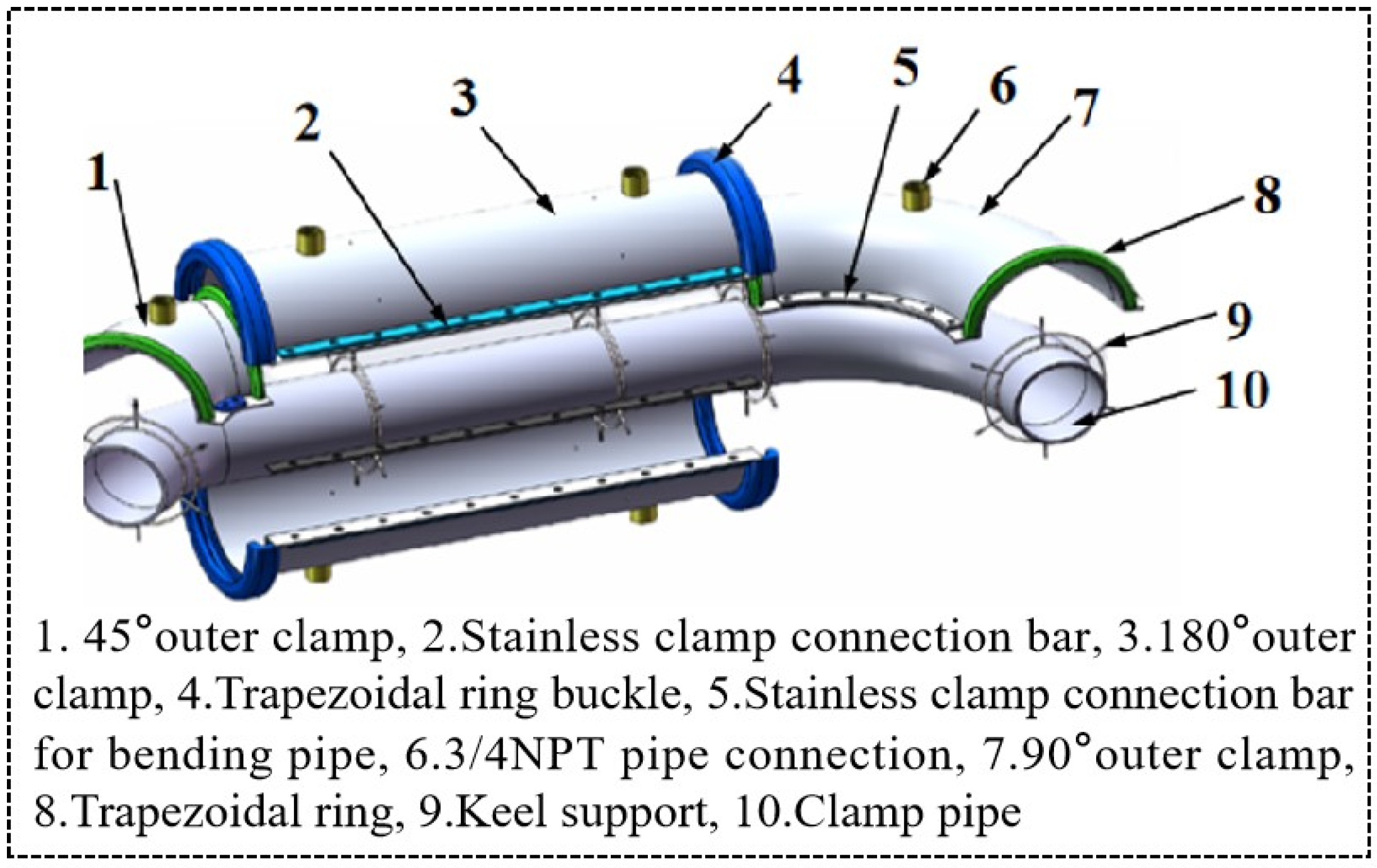
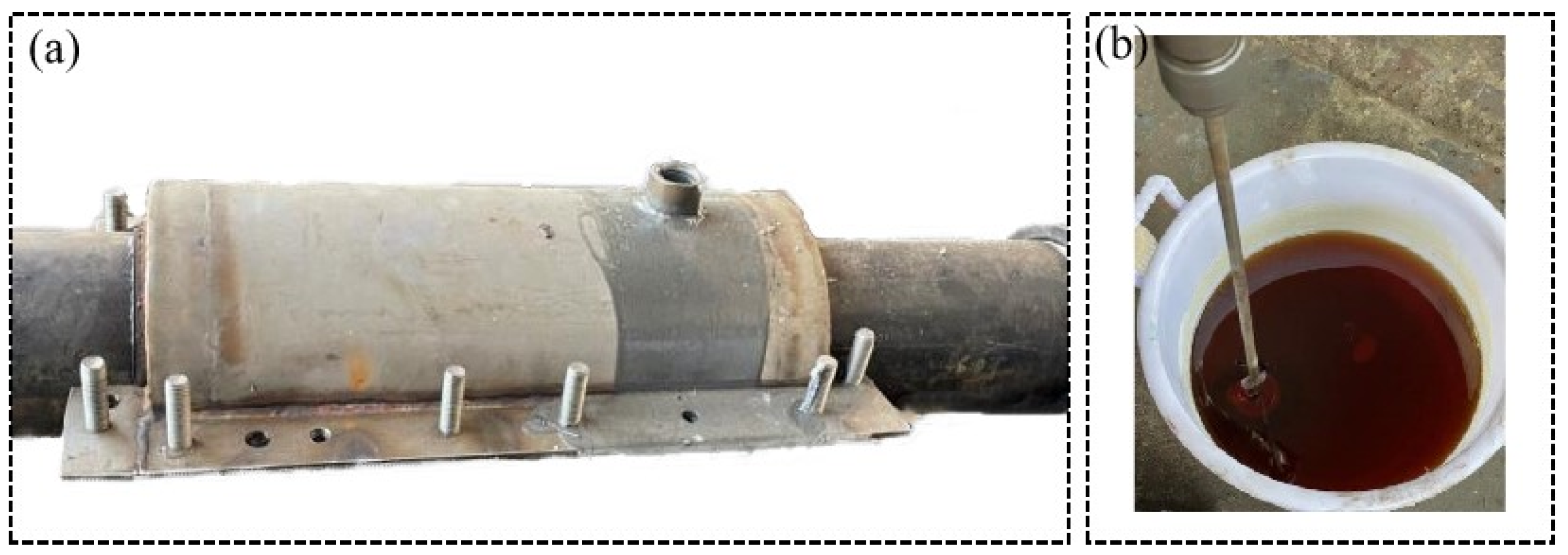



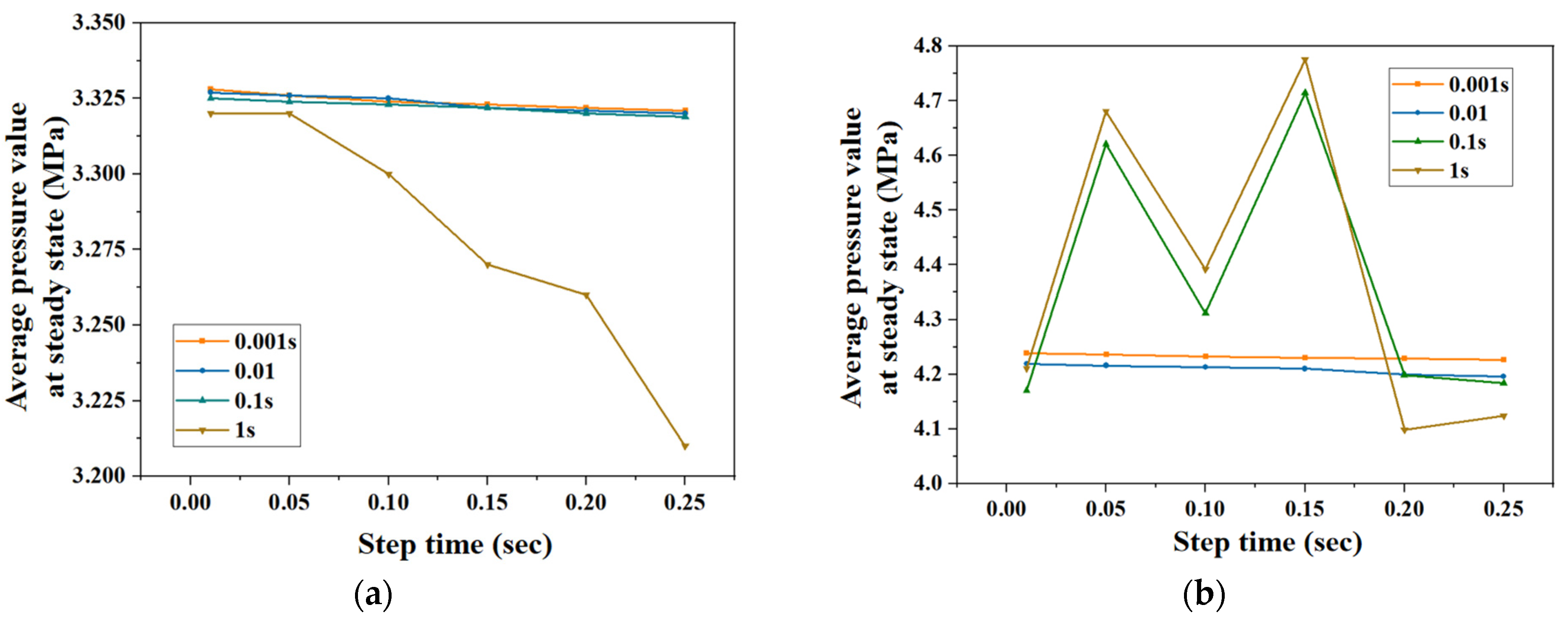

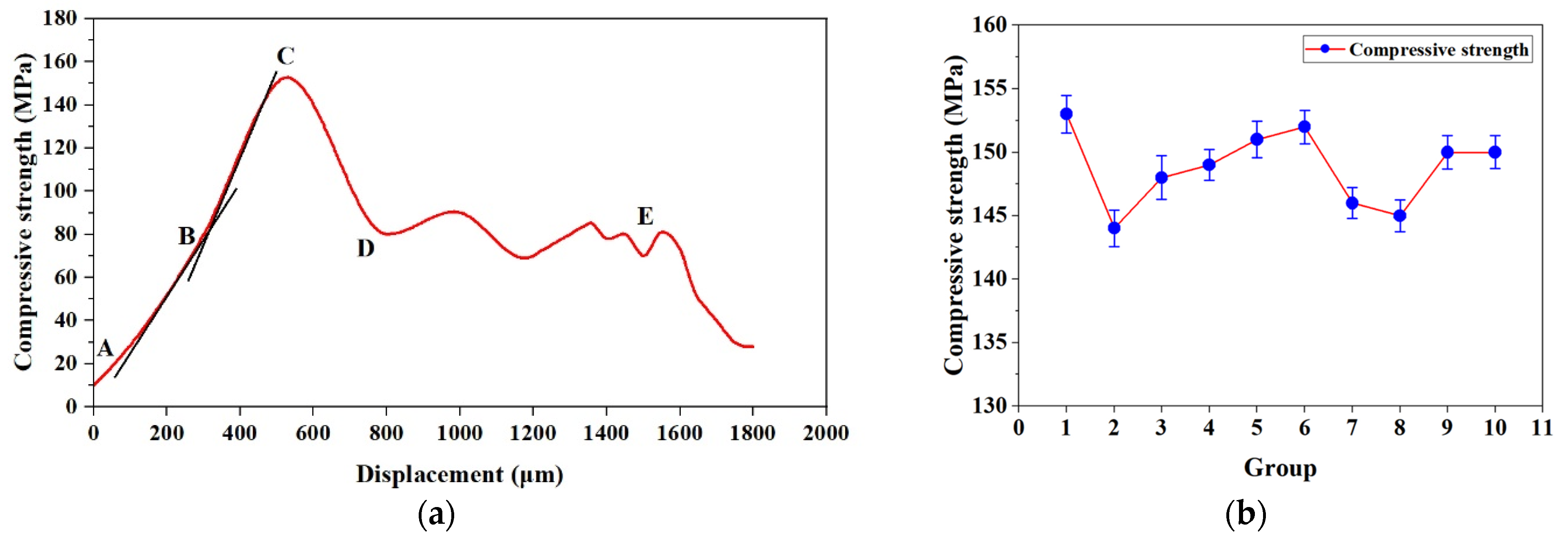

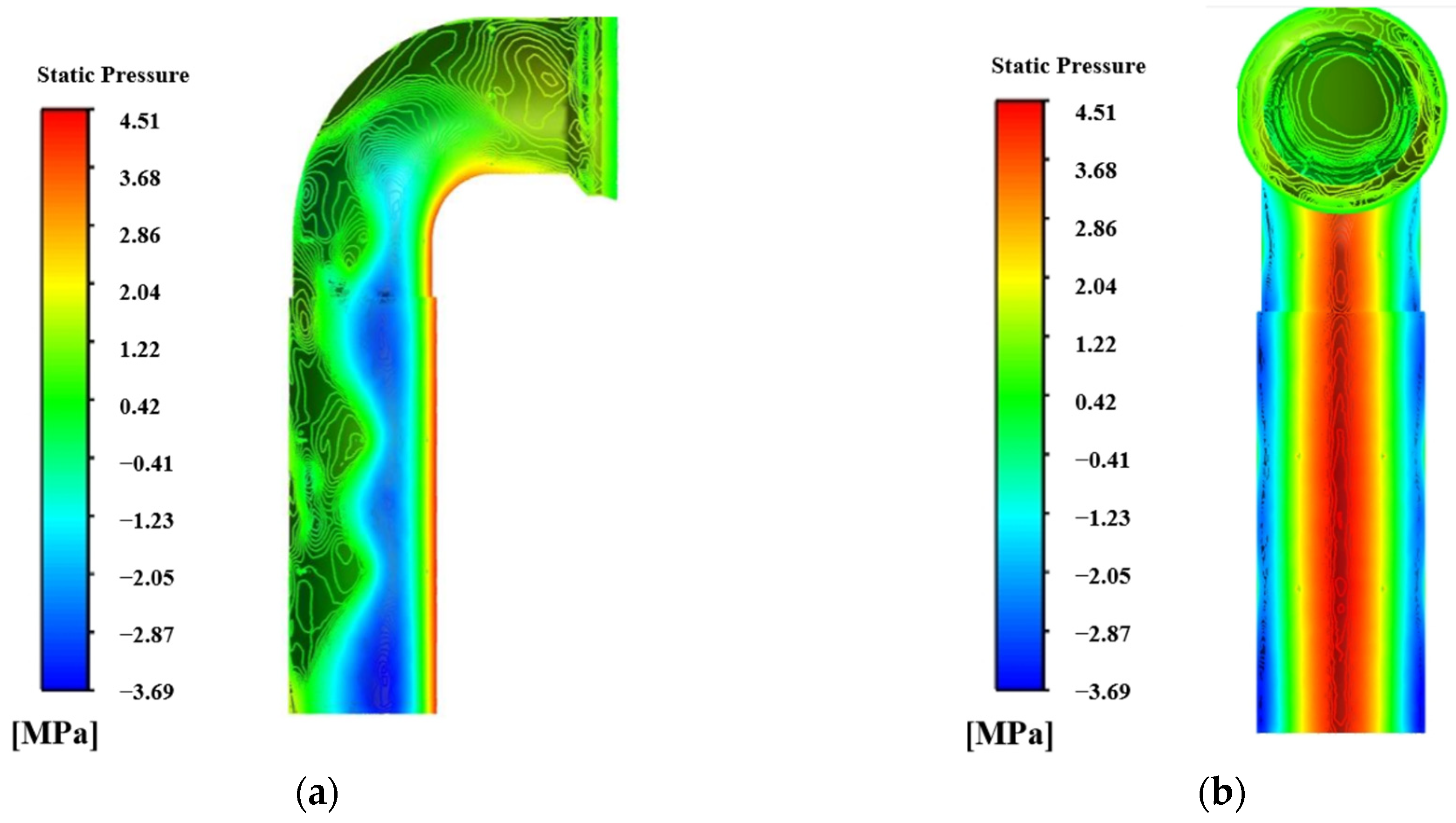
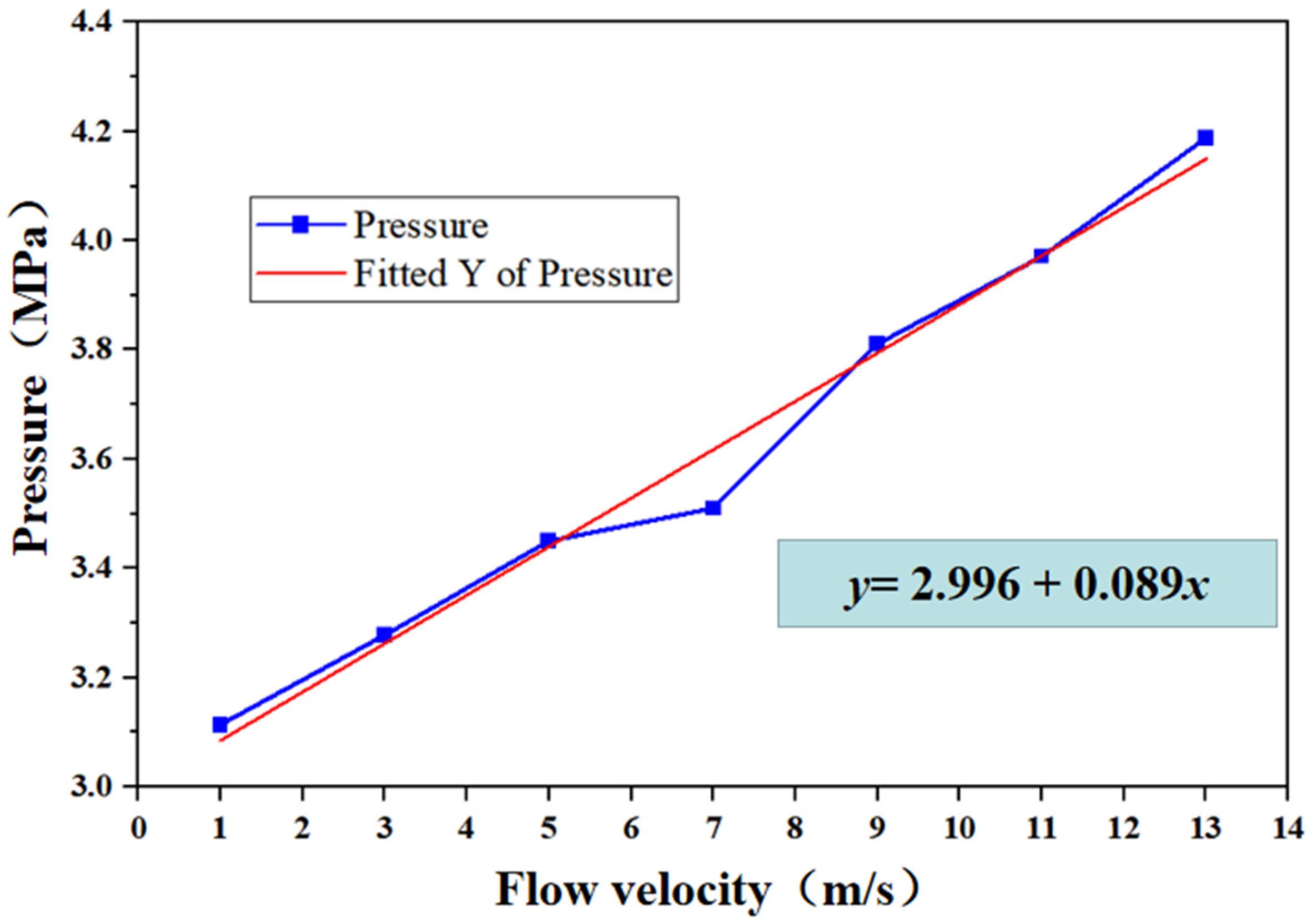
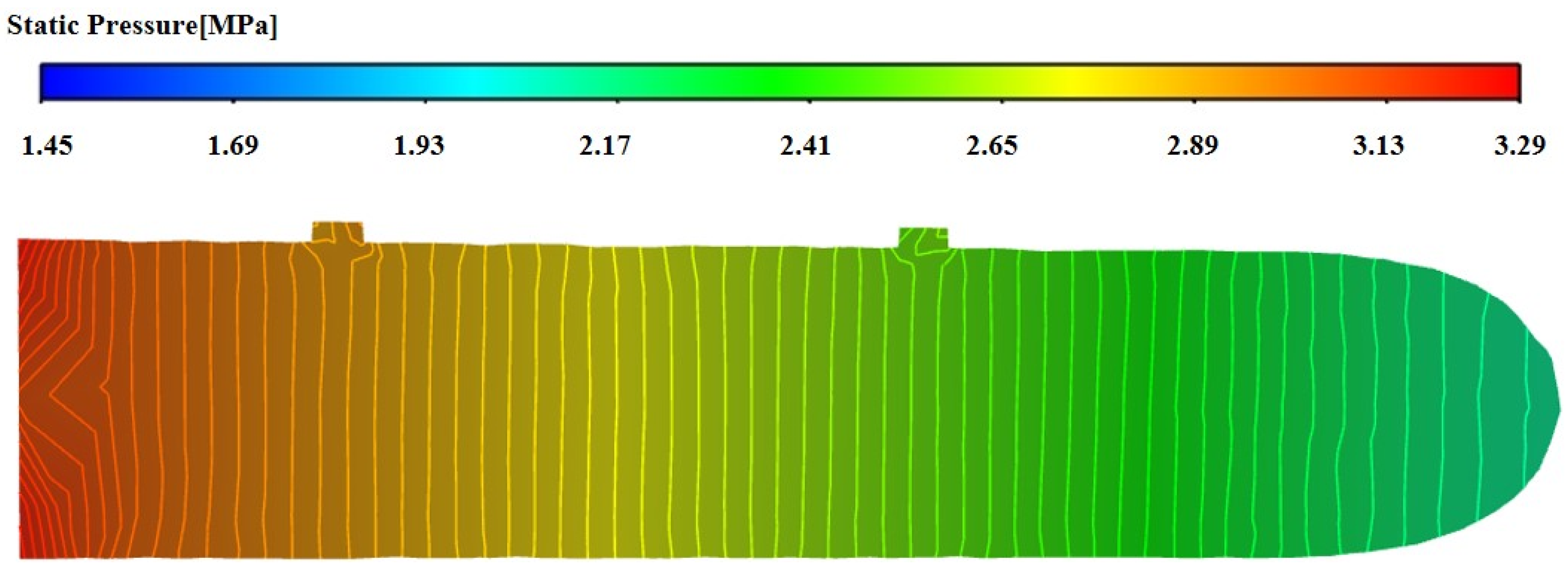

| Label | Liquid Mass Ratio (I:II) | Method of Stirring | Condition of Pressure |
|---|---|---|---|
| 1 | 100:10 | Hand stirring before pouring | Artificial pressure |
| 2 | 100:15 | Electric stirring before pouring | No pressure |
| 3 | 100:22 | ||
| 4 | 100:25 |
| Label | Flow Direction | Flow Velocity |
|---|---|---|
| 1 | X~(−X) | 1 m/s |
| 2 | X~(−Y) | 3 m/s |
| 3 | X~(−Z) | 5 m/s |
| 4 | Y~(−Z) | 7 m/s |
| 5 | Y~(−Y) | 11 m/s |
| 6 | Z~(−Z) | 13 m/s |
| Parameters | Value |
|---|---|
| Seawater viscosity, cP | 1.03 |
| Seawater density, kg/m3 | 1300 |
| Seawater velocity, m/s | 0~13 |
| Crude oil viscosity, cP | 180 |
| Crude oil density, kg/m3 | 950 |
| Crude oil velocity, m/s | 0~3 |
| Plugging agent density, kg/m3 | 700~2400 |
| Temperature, °C | −20~240 |
| Liquid plugging agent viscosity, cP | 30~60 |
| Environmental pressure, MPa | 3.1 |
Disclaimer/Publisher’s Note: The statements, opinions and data contained in all publications are solely those of the individual author(s) and contributor(s) and not of MDPI and/or the editor(s). MDPI and/or the editor(s) disclaim responsibility for any injury to people or property resulting from any ideas, methods, instructions or products referred to in the content. |
© 2023 by the authors. Licensee MDPI, Basel, Switzerland. This article is an open access article distributed under the terms and conditions of the Creative Commons Attribution (CC BY) license (https://creativecommons.org/licenses/by/4.0/).
Share and Cite
Lu, Y.; Liu, D.; Wei, X.; Xiao, Q.; Song, J.; Yu, Y. Study and Validation of a Novel Grouting Clamp Type Deepwater Oilfield Pipeline Repair Method Based on Computational Fluid Dynamics. Processes 2023, 11, 1142. https://doi.org/10.3390/pr11041142
Lu Y, Liu D, Wei X, Xiao Q, Song J, Yu Y. Study and Validation of a Novel Grouting Clamp Type Deepwater Oilfield Pipeline Repair Method Based on Computational Fluid Dynamics. Processes. 2023; 11(4):1142. https://doi.org/10.3390/pr11041142
Chicago/Turabian StyleLu, Yuliang, Dongtao Liu, Xinjie Wei, Qiaogang Xiao, Jiming Song, and Yajun Yu. 2023. "Study and Validation of a Novel Grouting Clamp Type Deepwater Oilfield Pipeline Repair Method Based on Computational Fluid Dynamics" Processes 11, no. 4: 1142. https://doi.org/10.3390/pr11041142
APA StyleLu, Y., Liu, D., Wei, X., Xiao, Q., Song, J., & Yu, Y. (2023). Study and Validation of a Novel Grouting Clamp Type Deepwater Oilfield Pipeline Repair Method Based on Computational Fluid Dynamics. Processes, 11(4), 1142. https://doi.org/10.3390/pr11041142





